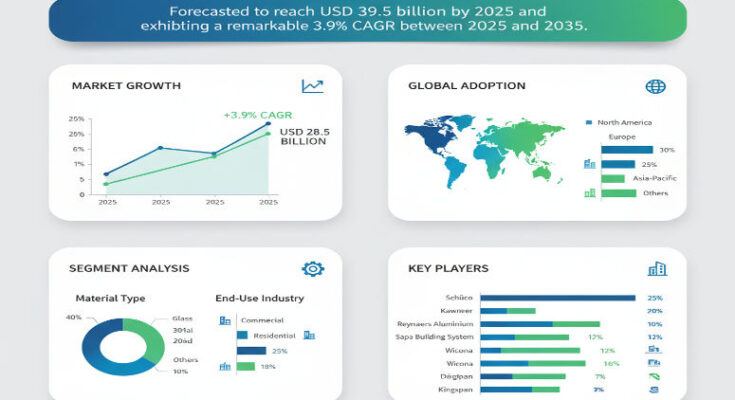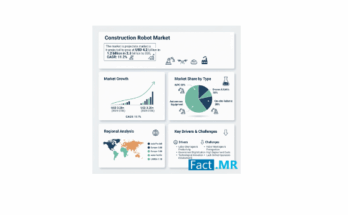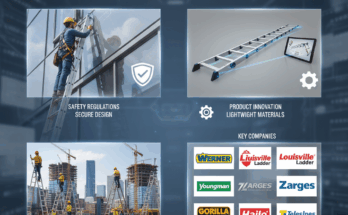The global facade systems market is projected to grow from USD 27.0 billion in 2025 to USD 39.5 billion by 2035, representing a compound annual growth rate (CAGR) of 3.9% over the decade. This expansion reflects increasing demand for advanced building envelopes, fueled by architectural innovation, energy-efficiency regulations, and rising construction activity across commercial, residential, and institutional sectors.
Market Drivers and Growth Catalysts
The evolution of facade systems is primarily driven by stricter building codes and sustainability mandates that require enhanced insulation, daylight management, and energy performance. Modern facades are no longer static exteriors—they are dynamic building skins designed to optimize environmental performance and visual appeal.
Advanced materials, including high-performance glass, ventilated cladding, and composite façades, are gaining traction as they help architects achieve compliance while maintaining design flexibility. The growing trend toward smart buildings is also encouraging integration of automated shading, responsive glazing, and sensor-based ventilation systems into facades.
Additionally, the renovation and retrofit segment is witnessing robust growth. Aging structures, especially in developed regions, are being upgraded with energy-efficient and modern façade systems to extend their lifespan and enhance property value.
Product Segmentation and Application Trends
The market can be broadly divided by product type, material, and end use. Glass facade systems remain the most dominant segment, capturing roughly 40% of global market share in 2025. Their popularity stems from their ability to balance natural lighting, energy efficiency, and modern architectural aesthetics.
Metal cladding systems—especially aluminum composite panels—are also widely used due to their durability, design flexibility, and lower maintenance costs. Other systems, including stone, ceramic, fiber cement, and concrete panels, serve niche applications focused on texture and aesthetic contrast.
By application, the commercial construction sector holds approximately 50% of total demand, driven by large-scale projects such as office towers, retail malls, and hospitality infrastructure. The residential and institutional segments are also growing, particularly in urban centers that are witnessing a surge in high-rise housing and public infrastructure developments.
Regional Insights and Opportunity Hotspots
Regionally, the Asia-Pacific market is poised for the fastest growth, supported by rapid urbanization, infrastructure expansion, and increasing investment in commercial real estate. Countries like China, India, and Indonesia are leading adopters of energy-efficient façade systems, aided by government initiatives promoting sustainable construction.
North America and Europe are mature yet evolving markets, driven by a strong focus on building renovation, energy conservation, and architectural modernization. Stricter environmental standards and high adoption of smart building technologies continue to sustain façade innovation across these regions.
Meanwhile, the Middle East and Africa are emerging as high-potential regions, with rising demand for advanced façade solutions in commercial complexes, hotels, and residential skyscrapers—especially in urban centers such as Dubai, Riyadh, and Doha.
Competitive Landscape and Strategic Trends
The competitive landscape of the facade systems market is marked by innovation and integration. Leading players are increasingly offering comprehensive solutions—from design and material supply to prefabrication and installation. These firms emphasize performance validation, weatherproofing, and quality assurance to ensure long-term reliability.
Key manufacturers are also investing in prefabricated façade modules that allow faster on-site installation and improved precision, reducing overall project time and labor costs. Integration of smart controls—such as dynamic shading and automated ventilation—has become a new frontier in façade innovation, aligning with the global push for energy-smart buildings.
Collaborations between façade system providers, architects, and engineering firms are becoming more common, helping to create customized, project-specific designs that meet both regulatory and aesthetic requirements.
Challenges and Market Restraints
Despite promising growth, the market faces a few headwinds. High production and installation costs remain a barrier, particularly for small-scale projects or developing economies. Advanced façades incorporating multiple material layers, thermal breaks, or mechanical systems require significant investment in both design and fabrication.
Retrofitting existing buildings can also pose challenges, as older structures often need reinforcement to support heavier or more complex façade systems. Moreover, regional differences in fire safety, wind resistance, and energy performance standards complicate the supply chain for multinational providers.
Forecast and Strategic Recommendations
The facade systems market is forecast to reach USD 39.5 billion by 2035, with consistent growth driven by sustainability initiatives and design innovation. To capture emerging opportunities, industry participants should:
-
Focus on developing cost-effective, energy-efficient materials tailored to regional climates.
-
Invest in modular and prefabrication technologies to streamline installation and reduce waste.
-
Strengthen partnerships with architects and construction firms to influence project specifications early in the design phase.
-
Prioritize R&D in dynamic and smart façade technologies that can adapt to changing weather and light conditions.
Browse Full Report: https://www.factmr.com/report/facade-systems-market
Editorial Perspective
The façade has transformed from a mere protective layer to a defining element of architectural identity and building performance. As the construction industry embraces digitalization and sustainability, façade systems stand at the intersection of art, engineering, and technology.
Manufacturers that blend aesthetic appeal with performance efficiency—while maintaining cost competitiveness—will lead the next era of building design. The next decade of façade evolution will be shaped by innovation in materials, smart functionality, and climate responsiveness, redefining how buildings interact with their environment.



